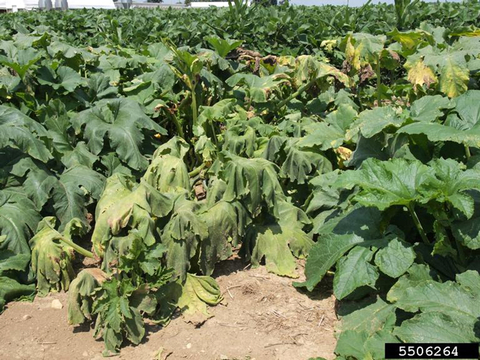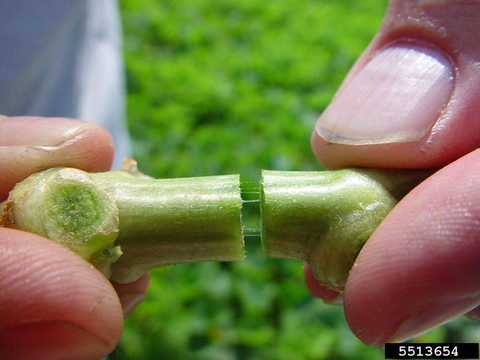Quick facts
- Bacterial wilt can cause severe losses in cucumbers and muskmelons. It is less common and less severe in pumpkins and squash.
- Plants wilt in the field. They often recover overnight but continue to wilt each day.
- Wilt is often isolated to a small area or individual plants.
- Wilt progresses down the vine until the entire vine wilts or dies.
- Leaves eventually yellow and brown at the margins, then completely wither and die.
- The bacteria overwinter in the gut of striped and spotted cucumber beetles. It cannot overwinter in Minnesota in plant debris.
- Managing cucumber beetles provides the most effective control of bacterial wilt.
- Pesticides will not cure a cucurbit plant infected with bacterial disease.
How to tell bacterial wilt apart from other cucurbit issues
- Leaves first appear dull green, wilt during the day and recover at night.
- Leaves eventually yellow and brown at the margins, completely wither and die.
- The speed of wilting varies by crop. Cucumbers and melons wilt and die rapidly. Pumpkins take up to two weeks to wilt completely. Summer squash may continue to produce for several weeks even when infected.
- Wilt progresses down the vine until the entire vine wilts or dies.
- Striped or spotted cucumber beetles will be present in the garden.
- If infected vines are cut close to the crown of the plant and the cross-sections pressed together, thread-like strands of bacterial ooze are visible when the two halves are gently pulled apart again. This method is not always effective because the threads can be hard to see without a microscope. If you see the thread-like strands, you can assume that you are seeing bacterial wilt. However, if you do not see them, you may still have bacterial wilt.
Biology
- The bacterium Erwinia tracheiphila causes bacterial wilt. This pathogen can cause severe losses in cucumbers and muskmelons. It does not affect squash and pumpkins as much. Bacterial wilt does not affect watermelon.
- The bacteria overwinter in the gut of striped and spotted cucumber beetles. Not all beetles carry the bacteria. Beetles that feed on infected plants pick up the bacteria. They then move to new plants, creating wounds through feeding. The bacteria are on the mouthparts or in the fecal matter of the beetle and enter the plant through the feeding wounds.
- The bacteria multiply rapidly within the plant and plug the vascular tissue, resulting in wilting of the vines. Once bacterial wilt infects a plant, there is no way to control the disease. The bacteria cannot transmit in seed, does not survive in soil, and only survives in plant debris for a short period. It cannot overwinter in Minnesota in plant debris.
- Bacterial wilt does not occur every year in Minnesota.
Managing bacterial wilt in the garden
|
- There are many things that can cause cucurbits to wilt. Make sure you are giving your plants enough water.
- Keep an eye out for plants that are wilting in the heat of the day but aren’t recovered by the next morning.
- Rule out squash vine borer by looking at the plant’s crown (the point where the stem meets the soil).
- There are a couple of varieties of different cucurbits with resistance to bacterial wilt.
- Check seed catalogues or the Disease Resistant Vegetable Varieties list for options.
- Manage cucumber beetle.
- Remove plants with bacterial wilt from the garden to keep beetles from moving the bacteria to other cucurbit
How to manage bacterial wilt on the farm
|
- Bacterial wilt can be hard to detect because many issues can cause wilting in cucurbits. Keep an eye out for plants that are wilting in the heat of the day, especially if plants aren’t recovered by the next morning.
- Rule out squash vine borer by looking at the plant’s crown.
- The only way to confirm a diagnosis is to submit a sample to the U of M Plant Disease Clinic.
- Cucumber beetles are also important to manage when preventing bacterial wilt.
- For cucumber beetles, scout at least weekly, increasing frequency once you find beetles.
- For recently emerged plants with one true leaf, treatment should be considered if there are 2+ cucumber beetles per plant on 1/4 of the plants.
- Once plants have 2 or more true leaves, Minnesota research suggests that treatment should be considered once beetles have defoliated 25% of leaves. This will help prevent defoliation and the potential for bacterial wilt to spread.
- There are a couple of varieties of different cucurbits with resistance to bacterial wilt.
- Check seed catalogues or the Disease Resistant Vegetable Varieties list for options.
- If disease appears in a few plants, rogue and bury these plants to prevent further spread of the disease.
- Managing cucumber beetles is the most effective way to prevent bacterial wilt.
- Excluding cucumber beetles is very effective. In the field, floating row covers can be placed as seedlings emerge and plants start to grow, just make sure to remove them as flowers appear to allow pollination.
- In the hoop house or greenhouse, research at Purdue has shown insect exclusion screens can keep cucumber beetles out of the hoop house. A screen size of 0.8 x 1.0 mm is able to keep beetles out while also allowing for ventilation.
- Trap crops, or cucurbit cultivars that are highly attractive to pests, can be used to reduce feeding on the crops we actually want to harvest. Research in Missouri and the Northeast has found blue hubbard squash to be a good trap crop.
- Removing or destroying crop residue will make it harder for cucumber beetles to find a spot to overwinter.
- Pesticides will not help in managing a cucurbit plant infected with this bacterial disease.
- Managing cucumber beetles provides the most effective control of bacterial wilt.
- Research in Massachusetts found that Surround (kaolin clay) did reduce beetle numbers, and research in New York found Surround helped reduce defoliation in zucchini.
- See the Midwest Vegetable Production Guide for products to control cucumber beetles.
CAUTION: Mention of a pesticide or use of a pesticide label is for educational purposes only. Always follow the pesticide label directions attached to the pesticide container you are using. Be sure that the plant you wish to treat is listed on the label of the pesticide you intend to use. And observe the number of days between pesticide application and when you can harvest your crop. Remember, the label is the law.
Reviewed in 2022




